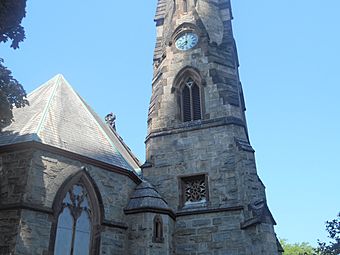Trinity-St. Paul's Episcopal Church (New Rochelle, New York) facts for kids
Quick facts for kids |
|
|
Trinity-St. Paul's Episcopal Church
|
|

The clock tower at Trinity-St. Paul's Episcopal Church
|
|
| Location | 311 Huguenot St., New Rochelle, New York |
|---|---|
| Area | 1.6 acres (0.65 ha) |
| Built | 1862-1864 |
| Architect | Richard Upjohn & Son; F. Carlos Merry |
| Architectural style | Gothic Revival |
| NRHP reference No. | 06000576 |
| Added to NRHP | July 12, 2006 |
Trinity-St. Paul's Episcopal Church is a historic church in New Rochelle, New York. It was added to the National Register of Historic Places in 2006. You can find it at the corner of Huguenot Street and Division Street.
This church has a long history. It started with a group of French Huguenot settlers in New Rochelle. In 1709, many of them joined the Church of England. King George III gave the church its first official charter in 1762. After the American Revolutionary War, Trinity Church became part of the Protestant Episcopal Church of America.
Contents
Building History
The church building you see today is the third one built by this group. It replaced an older wooden church from 1823-1824. The land for the church was given to the wardens in 1743.
Work on the current stone church began on August 13, 1862. It opened for services on September 13, 1863. The tall tower was finished on November 30, 1864. The famous architects Richard Upjohn & Son designed the church. They were known for their beautiful gothic revival style.
In 1892, a parish house was added next to the church. It was built with the same granite and brownstone materials. Architect Frederick Carles Merry designed this addition.
Special Church Treasures
Inside the church, there are many old and special items. These 'heirlooms' have been passed down for over 300 years. They show the long history of the church and the New Rochelle area.
Queen Anne Chalice
One amazing treasure is a silver chalice. Queen Anne of England gave it to the church in 1709. This was after the church joined the Church of England. The chalice has "Anne Regina" carved into it, which means "Queen Anne."
Stained Glass Windows
The beautiful stained glass windows in the chancel (the area near the altar) honor the church's first three ministers. Their names were Rev. Bondet, Rev. Pierre Stouppe, and Rev. Michael Houdin.
Many other stained glass windows fill the church with color. Some of these were made by the famous Tiffany company. These windows remember important church members from the 1800s and 1900s.
The Old Bell
In the church tower, you can find an old bell. This bell was originally from the French Huguenot Church in New York City. In 1823, it was given to Trinity Church in New Rochelle. It hung in the tower of the old wooden church before moving to the current building.
Huguenot Burying Ground
The land around the church and parish house has a very rich history. It includes three old town cemeteries that are now combined into one.
Early Burials
The first cemetery, called "Trinity Graveyard," started in 1802. It was located west of the current Parish House. Another burial ground was for the Allaire family, who were early members of the community. The oldest cemetery, the Huguenot Burying Ground, was given to the town in 1693 by Louis Bongrand. He was one of the first Huguenot settlers. This land was meant for a churchyard to bury the dead.
Over time, Trinity Church acquired more land. The boundaries between these three cemeteries disappeared.
Moving Graves for Roads
In 1849, the New York-New Haven railway line was built. It cut through the village and split the church's land. Later, in 1956, the New England Thruway highway was planned. This new highway needed land where the Huguenot Burying Ground and the Allaire family cemetery were located.
Because of this, many graves had to be moved. The New England Thruway paid for this big effort. The remains of early New Rochelle residents and their descendants were carefully dug up. They were placed in special boxes and reburied on the church's land.
It's believed that over 400 Huguenots and even some Siwanoy Indian "friends" were buried in the original cemetery. Today, a monument in the Trinity yard marks the reburied graves of those whose names are unknown. The headstones that were saved are placed nearby.
This "Huguenot Memorial Cemetery" is now recognized as a historic cemetery. It is the resting place for many of the original Huguenot founders, early settlers, and other important citizens of New Rochelle.
Gallery





